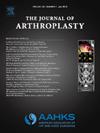新冠肺炎相关骨坏死的危险因素、发病机制、诊断和治疗方案:系统综述
IF 3.8
2区 医学
Q1 ORTHOPEDICS
引用次数: 0
摘要
导论:与COVID-19相关的骨坏死是一种相对罕见的临床实体,但在大流行期间发病率很高。关于这组骨坏死患者的特征数据缺乏。本研究的目的是系统地回顾文献,以确定:1)COVID-19骨坏死的临床表现/流行病学,2)病理生理学,3)诊断方式,以及4)治疗指南/算法。方法:使用系统评价和荟萃分析首选报告项目(PRISMA)指南,我们对三个数据库进行了系统评价,共纳入了10篇文章。如果文章提供以下数据,则符合纳入标准:1)临床表现/流行病学,2)病理生理学,3)诊断方式,和/或4)COVID-19骨坏死的治疗指南/算法。结果:COVID-19感染与骨坏死症状之间的持续时间存在相当大的差异。新冠肺炎相关骨坏死的临床表现与标准症状相似,包括关节痛和负重痛。皮质类固醇往往是与covid - 19相关的骨坏死最可识别的相关危险因素。诊断包括x光片和磁共振成像(MRI)进行明确诊断。治疗取决于骨坏死进展的速度,从双膦酸盐和镇痛药到关节保留手术和全关节置换术(TJA)。讨论:尽管与新冠肺炎相关的骨坏死是一种罕见的临床疾病,但骨科医生应该意识到这一点,并对患者进行精心筛查。对于接种了COVID-19病毒的患者,外科医生必须利用有关COVID-19相关骨坏死的临床表现、病理生理学、诊断和治疗等信息,对患者进行适当筛查和管理。本文章由计算机程序翻译,如有差异,请以英文原文为准。
Risk Factors, Pathogenesis, Diagnosis, and Treatment Options for COVID-Associated Osteonecrosis: A Systematic Review
Background
Osteonecrosis associated with COVID-19 is a relatively rare clinical entity, but with a high incidence during the pandemic. There is a paucity of data regarding the characterization of this group of osteonecrosis patients. The purpose of this investigation was to systematically review the literature to identify: (1) clinical presentation/epidemiology, (2) pathophysiology, (3) diagnostic modalities, and (4) treatment guidelines/algorithms of COVID-19 osteonecrosis.
Methods
Using the Preferred Reporting Items for Systematic Reviews and Meta-Analyses guidelines, we conducted a systematic review across three databases, resulting in a total of 10 articles. Articles met the inclusion criteria if they provided data regarding: (1) clinical presentation/epidemiology, (2) pathophysiology, (3) diagnostic modalities, and/or (4) treatment guidelines/algorithms of COVID-19 osteonecrosis.
Results
There was considerable variability in duration between COVID-19 infection and osteonecrosis symptoms. The clinical presentation of COVID-associated osteonecrosis is similar to standard symptoms, including joint pain and pain with weight-bearing. Corticosteroids tended to be the most identifiable associated risk factor for COVID-associated osteonecrosis. Diagnosis included radiographs and magnetic resonance imaging for definitive diagnosis. Treatment varied depending on the rapidity of osteonecrosis progression, ranging from bisphosphonates and analgesics to joint-preserving procedures and total joint arthroplasty.
Conclusions
Although COVID-associated osteonecrosis is a rare clinical condition, it is one that orthopaedic surgeons should be aware of and meticulously screen for in their patients. For patients inoculated with the COVID-19 virus, it is important for surgeons to use information regarding clinical presentation, pathophysiology, diagnosis, and treatment of COVID-associated osteonecrosis to screen and manage patients appropriately.
求助全文
通过发布文献求助,成功后即可免费获取论文全文。
去求助
来源期刊

Journal of Arthroplasty
医学-整形外科
CiteScore
7.00
自引率
20.00%
发文量
734
审稿时长
48 days
期刊介绍:
The Journal of Arthroplasty brings together the clinical and scientific foundations for joint replacement. This peer-reviewed journal publishes original research and manuscripts of the highest quality from all areas relating to joint replacement or the treatment of its complications, including those dealing with clinical series and experience, prosthetic design, biomechanics, biomaterials, metallurgy, biologic response to arthroplasty materials in vivo and in vitro.
 求助内容:
求助内容: 应助结果提醒方式:
应助结果提醒方式:


